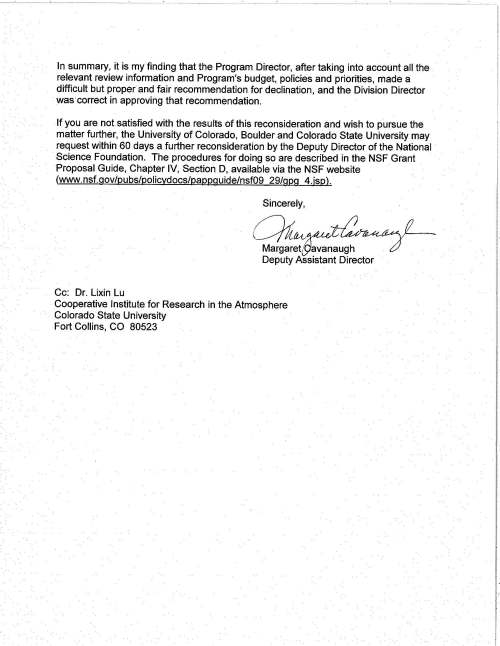On May 18 2010 I posted on a proposal to NSF that was highly rated each time it was submitted, but was rejected each of the three times it was submitted after further revisions were made.
The May post is
Is The NSF Funding Process Working Correctly?
The NSF mission reads
The National Science Foundation Act of 1950 (Public Law 81-507) set forth NSF’s mission and purpose:
To promote the progress of science; to advance the national health, prosperity, and welfare; to secure the national defense….
The Act authorized and directed NSF to initiate and support:
- basic scientific research and research fundamental to the engineering process,
- programs to strengthen scientific and engineering research potential,
- science and engineering education programs at all levels and in all the various fields of science and engineering,
- programs that provide a source of information for policy formulation,
- and other activities to promote these ends.
Over the years, NSF’s statutory authority has been modified in a number of significant ways. In 1968, authority to support applied research was added to the Organic Act. In 1980, The Science and Engineering Equal Opportunities Act gave NSF standing authority to support activities to improve the participation of women and minorities in science and engineering. Another major change occurred in 1986, when engineering was accorded equal status with science in the Organic Act.
NSF has always dedicated itself to providing the leadership and vision needed to keep the words and ideas embedded in its mission statement fresh and up-to-date. Even in today’s rapidly changing environment, NSF’s core purpose resonates clearly in everything it does: promoting achievement and progress in science and engineering and enhancing the potential for research and education to contribute to the Nation. While NSF’s vision of the future and the mechanisms it uses to carry out its charges have evolved significantly over the last four decades, its ultimate mission remains the same.
The title and Project Summary of our rejected proposal is
“Collaborative Research: Sensitivity of Weather and Climate in the Eastern United States to Historical Land-Cover Changes since European Settlement”
with the Project Summary
“The Earth’s weather and climate is strongly influenced by the properties of the underlying surface. Much of the solar energy that drives the atmosphere first interacts with the land or sea surface. Over land regions this interaction is modulated by surface characteristics such as albedo, aerodynamic roughness length, leaf area index (LAI), etc. As these characteristics change, either from anthropogenic or natural land-cover disturbances, the amount of energy reaching the atmosphere from the land surface, and thus weather and climate, is expected to change. The goal of this project is to determine the sensitivity of weather and climate to historical land-cover changes in the eastern United States since the arrival of European settlers. Regional Atmospheric Modeling System (RAMS) coupled with the Simple Biosphere (SiB) model, SiB-RAMS, will be used to perform a series of one-year ensemble simulations over the eastern United States with the present-day and several past land-cover distributions. The land-cover distributions will be based on the new Reconstructed Historical Land Cover and Biophysical Parameter Dataset developed by Steyaert and Knox (2008). The influence of the land-cover changes on temperature and precipitation will be examined and compared with that expected from CO2-induced climate change (IPCC 2007). The seasonality of the changes in precipitation and temperature due to land-cover change will be explored. Also, the relative importance of each land-cover biophysical parameter to the total simulated change in temperature and precipitation will be assessed.”
We have presented the letter from the Deputy Assistant Director regarding our request for reconsideration.
This letter is quite informative as it is a cursory, pro forma response without any detail. What it confirms is that program managers have considerable latitude in decision-making and can eliminate well reviewed projects if they differ from their priorities. The program managers decide what is “basic scientific research and research fundamental to the engineering process” rather than relying on the reviewers to determine this [of course, they can also select known biased reviewers if they want to reject a proposal].
Since the level of ratings of our proposal were high, the reason for the rejection is based on the program managers concluding that the role of land use change in the climate system is not a high research priority. Also, despite the NSF requirement listed their mission statement “to support activities to improve the participation of women and minorities in science and engineering”, the fact that woman (Dr. Lixin Lu) was the PI on the project was not discussed in the reconsideration.

 My recommendation to improve the process, which I presented in my May post is
My recommendation to improve the process, which I presented in my May post is
I also recommend they make easily available the list of all of the reviewers used during the year within each NSF program office.
NSF program managers have considerable ability to slant research that they fund with insufficent transparency of the review process. This has become quite a problem in the climate science area where, as one example, in recent years they have elected to fund climate predictions decades into the future (e.g. see which was funded in part by the NSF; I will discuss specific examples of such funded projects by the NSF in a future post).
